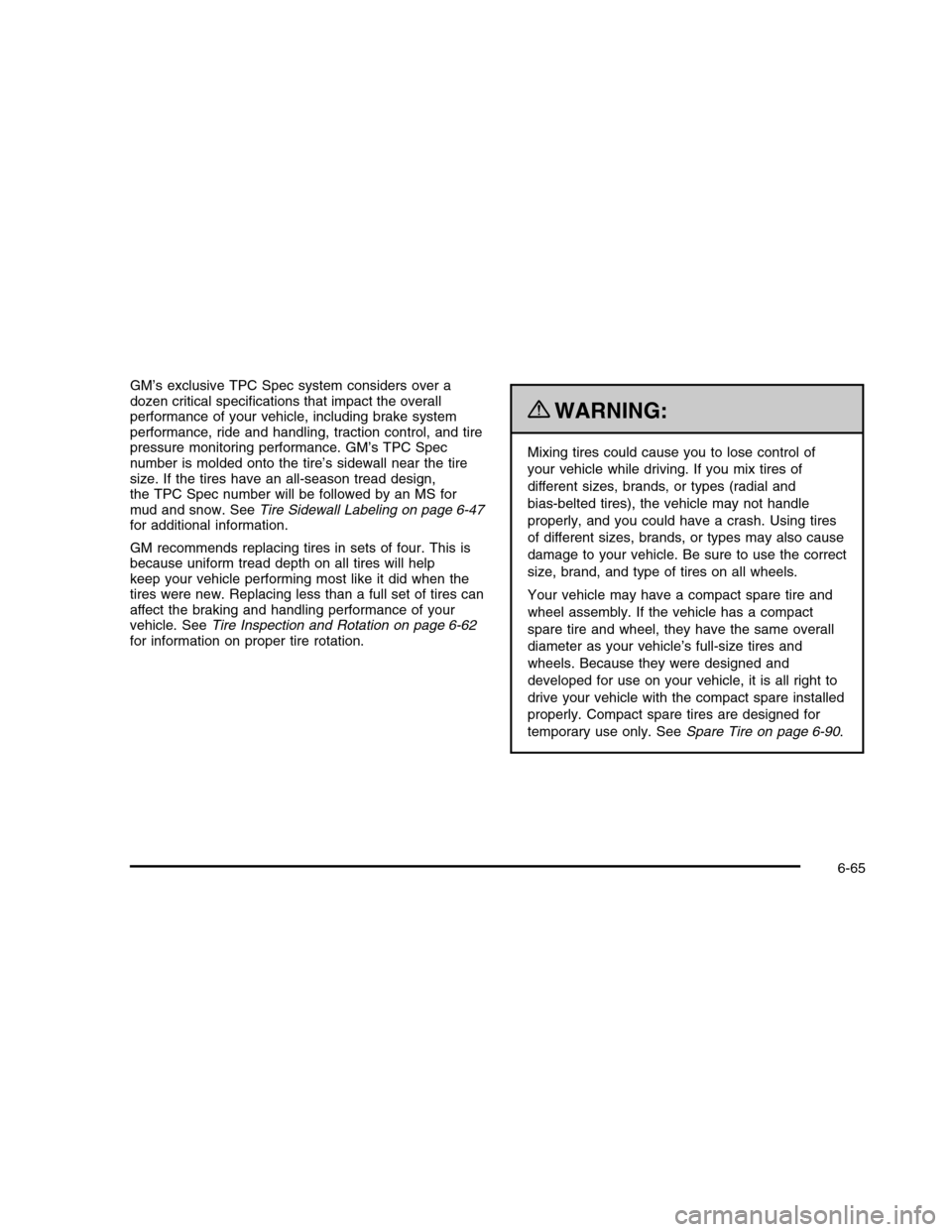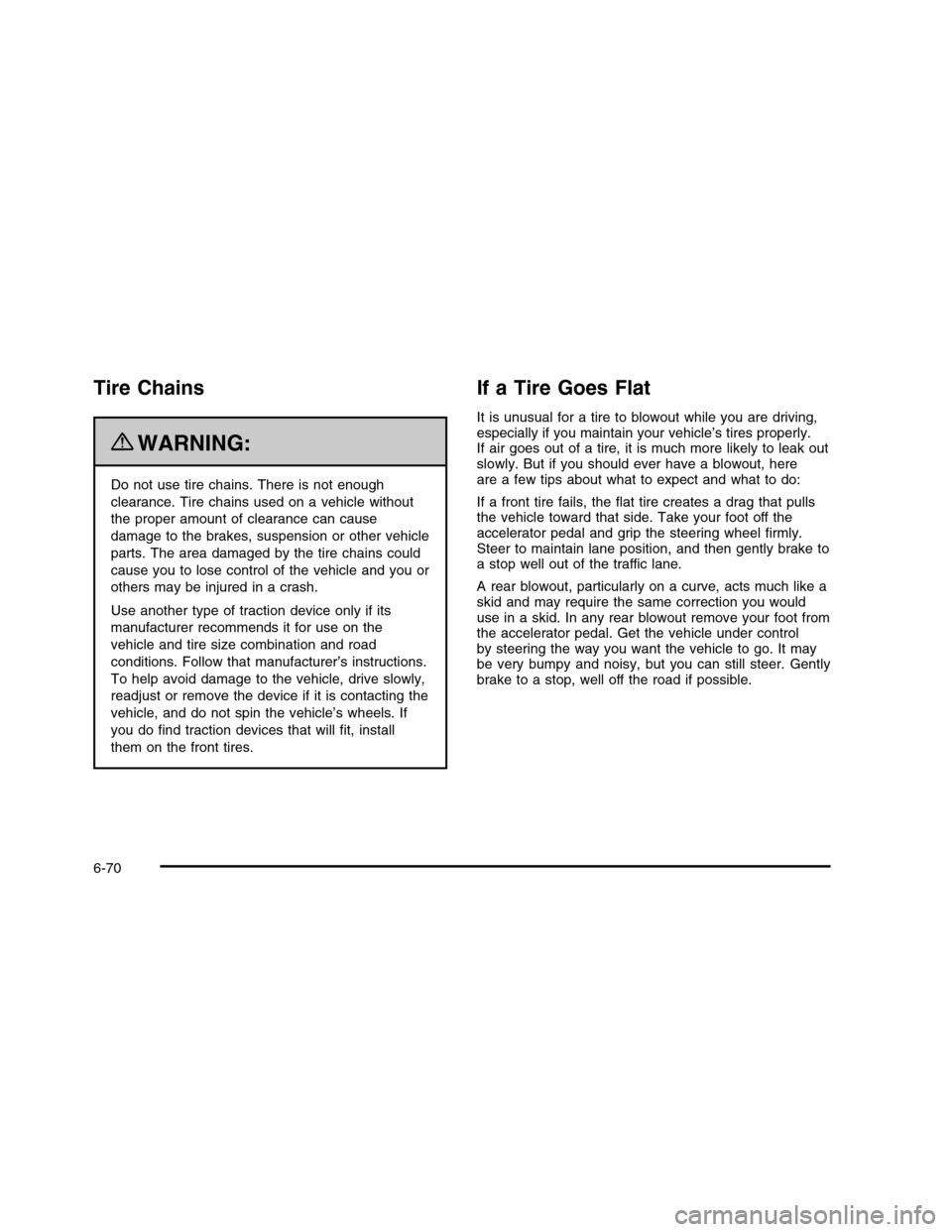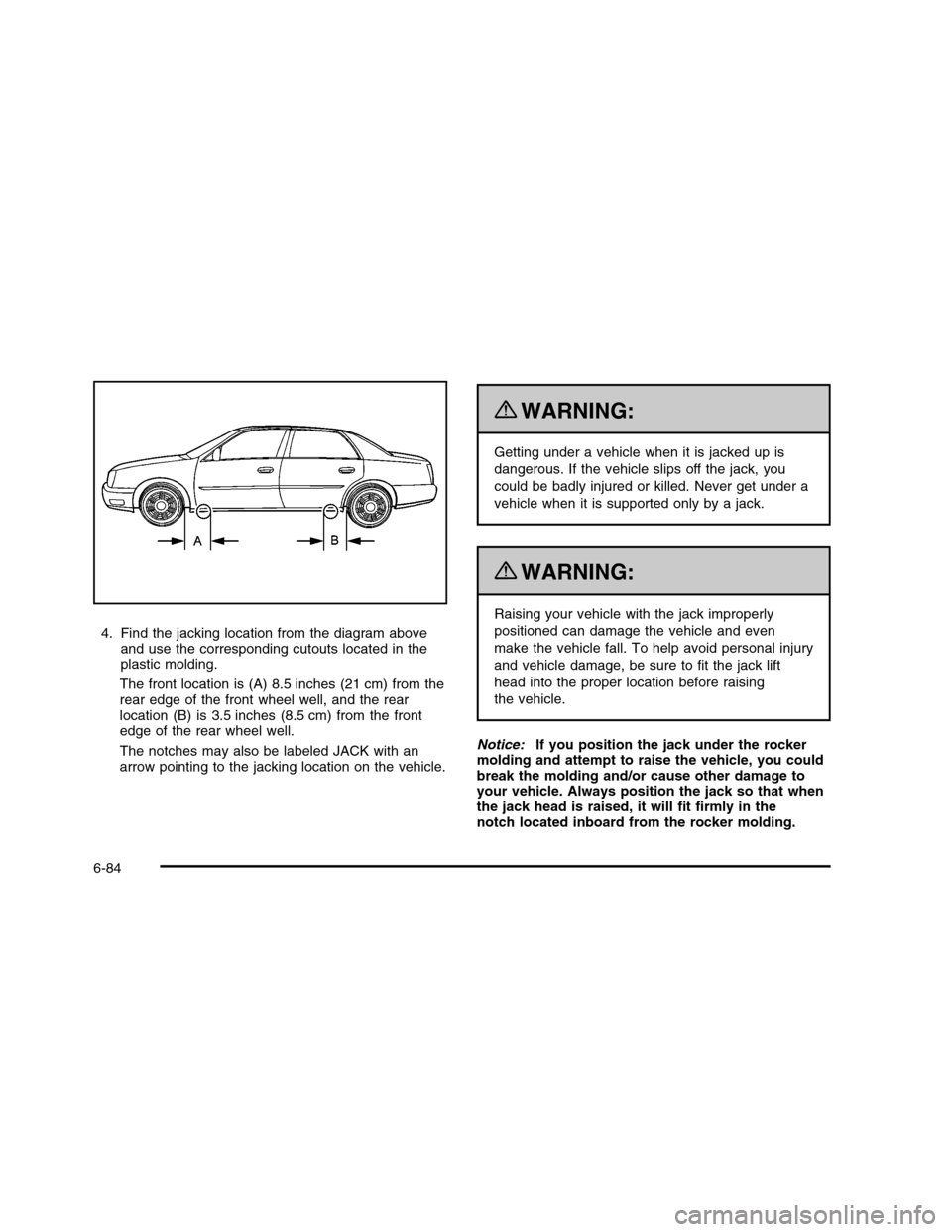ESP CADILLAC DTS 2010 1.G Workshop Manual
[x] Cancel search | Manufacturer: CADILLAC, Model Year: 2010, Model line: DTS, Model: CADILLAC DTS 2010 1.GPages: 480, PDF Size: 17.56 MB
Page 373 of 480

Load Index:An assigned number ranging from1 to 279 that corresponds to the load carryingcapacity of a tire.
Maximum Inflation Pressure:The maximum airpressure to which a cold tire can be inflated. Themaximum air pressure is molded onto the sidewall.
Maximum Load Rating:The load rating for a tireat the maximum permissible inflation pressurefor that tire.
Maximum Loaded Vehicle Weight:The sum ofcurb weight, accessory weight, vehicle capacityweight, and production options weight.
Normal Occupant Weight:The number ofoccupants a vehicle is designed to seat multipliedby 150 lbs (68 kg). SeeLoading the Vehicle onpage 5-18.
Occupant Distribution:Designated seatingpositions.
Outward Facing Sidewall:The side of anasymmetrical tire that has a particular side thatfaces outward when mounted on a vehicle. Theside of the tire that contains a whitewall, bearswhite lettering, or bears manufacturer, brand,and/or model name molding that is higher or deeperthan the same moldings on the other sidewall ofthe tire.
Passenger (P-Metric) Tire:A tire used onpassenger cars and some light duty trucks andmultipurpose vehicles.
Recommended Inflation Pressure:Vehiclemanufacturer’s recommended tire inflationpressure as shown on the tire placard. SeeInflation - Tire Pressure on page 6-54andLoadingthe Vehicle on page 5-18.
Radial Ply Tire:A pneumatic tire in which theply cords that extend to the beads are laid at90 degrees to the centerline of the tread.
Rim:A metal support for a tire and upon whichthe tire beads are seated.
Sidewall:The portion of a tire between the treadand the bead.
Speed Rating:An alphanumeric code assigned toa tire indicating the maximum speed at which atire can operate.
Traction:The friction between the tire and theroad surface. The amount of grip provided.
Tread:The portion of a tire that comes intocontact with the road.
6-53
Page 375 of 480

A Tire and Loading Information label is attached tothe vehicle’s center pillar. This label lists yourvehicle’s original equipment tires and shows thecorrect inflation pressures for your tires when theyare cold. The recommended cold tire inflationpressure, shown on the label, is the minimumamount of air pressure needed to supportyour vehicle’s maximum load carrying capacity.
For additional information regarding how muchweight your vehicle can carry, and an example ofthe Tire and Loading Information label, seeLoading the Vehicle on page 5-18. How you loadyour vehicle affects the vehicle handling andride comfort, never load your vehicle with moreweight than it was designed to carry.
When to Check
Check your tires once a month or more. Do notforget to check the spare tire. If your vehicle has acompact spare tire, it should be at 60 psi (420 kPa).For additional information seeSpare Tire onpage 6-90.
How to Check
Use a good quality pocket-type gage to check tirepressure. You cannot tell if your tires areproperly inflated simply by looking at them. Radialtires may look properly inflated even when theyare under-inflated. Check the tire’s inflationpressure when the tires are cold. Cold means yourvehicle has been sitting for at least three hoursor driven no more than 1 mile (1.6 km).
Remove the valve cap from the tire valve stem.Press the tire gage firmly onto the valve toget a pressure measurement. If the cold tireinflation pressure matches the recommendedpressure on the Tire and Loading Informationlabel, no further adjustment is necessary. If theinflation pressure is low, add air until you reach therecommended amount.
If you overfill the tire, release air by pushing onthe metal stem in the center of the tire valve.Re-check the tire pressure with the tire gage.
Be sure to put the valve caps back on the valvestems. They help prevent leaks by keeping out dirtand moisture.
6-55
Page 377 of 480

If your vehicle has P235/55R17 or P245/50R18 sizetires, and you will be driving at speeds of 100 mph(160 km/h) or higher, where it is legal, set the coldinflation pressure to the maximum inflation pressureshown on the tire sidewall, or 38 psi (265 kPa),whichever is lower. See the example following.
Example:
You will find the maximum load and inflation pressuremolded on the tire’s sidewall, in small letters, nearthe rim flange. It will read something like this: Maximumload 690 kg (1521 lbs) 300 kPa (44 psi) Max. Press.
For this example, you would set the inflation pressure forhigh-speed driving at 38 psi (265 kPa).
When you end this high-speed driving, return the tires tothe cold inflation pressure shown on the Tire andLoading Information label. SeeLoading the Vehicle onpage 5-18.
Tire Pressure Monitor System
The Tire Pressure Monitor System (TPMS) uses radioand sensor technology to check tire pressure levels. TheTPMS sensors monitor the air pressure in yourvehicle’s tires and transmit tire pressure readings to areceiver located in the vehicle.
Each tire, including the spare (if provided), should bechecked monthly when cold and inflated to the inflationpressure recommended by the vehicle manufactureron the vehicle placard or tire inflation pressure label.(If your vehicle has tires of a different size than the sizeindicated on the vehicle placard or tire inflationpressure label, you should determine the proper tireinflation pressure for those tires.)
As an added safety feature, your vehicle has beenequipped with a tire pressure monitoring system (TPMS)that illuminates a low tire pressure telltale when oneor more of your tires is significantly under-inflated.
Accordingly, when the low tire pressure telltaleilluminates, you should stop and check your tires assoon as possible, and inflate them to the properpressure. Driving on a significantly under-inflated tirecauses the tire to overheat and can lead to tire failure.Under-inflation also reduces fuel efficiency and tiretread life, and may affect the vehicle’s handlingand stopping ability.
Please note that the TPMS is not a substitute for propertire maintenance, and it is the driver’s responsibility tomaintain correct tire pressure, even if under-inflation hasnot reached the level to trigger illumination of theTPMS low tire pressure telltale.
6-57
Page 385 of 480

GM’s exclusive TPC Spec system considers over adozen critical specifications that impact the overallperformance of your vehicle, including brake systemperformance, ride and handling, traction control, and tirepressure monitoring performance. GM’s TPC Specnumber is molded onto the tire’s sidewall near the tiresize. If the tires have an all-season tread design,the TPC Spec number will be followed by an MS formud and snow. SeeTire Sidewall Labeling on page 6-47for additional information.
GM recommends replacing tires in sets of four. This isbecause uniform tread depth on all tires will helpkeep your vehicle performing most like it did when thetires were new. Replacing less than a full set of tires canaffect the braking and handling performance of yourvehicle. SeeTire Inspection and Rotation on page 6-62for information on proper tire rotation.
{WARNING:
Mixing tires could cause you to lose control of
your vehicle while driving. If you mix tires of
different sizes, brands, or types (radial and
bias-belted tires), the vehicle may not handle
properly, and you could have a crash. Using tires
of different sizes, brands, or types may also cause
damage to your vehicle. Be sure to use the correct
size, brand, and type of tires on all wheels.
Your vehicle may have a compact spare tire and
wheel assembly. If the vehicle has a compact
spare tire and wheel, they have the same overall
diameter as your vehicle’s full-size tires and
wheels. Because they were designed and
developed for use on your vehicle, it is all right to
drive your vehicle with the compact spare installed
properly. Compact spare tires are designed for
temporary use only. SeeSpare Tire on page 6-90.
6-65
Page 387 of 480

Uniform Tire Quality Grading
Quality grades can be found where applicable onthe tire sidewall between tread shoulder andmaximum section width. For example:
Treadwear 200 Traction AA
Temperature A
The following information relates to the systemdeveloped by the United States National HighwayTraffic Safety Administration (NHTSA), whichgrades tires by treadwear, traction, andtemperature performance. This applies only tovehicles sold in the United States. The grades aremolded on the sidewalls of most passenger cartires. The Uniform Tire Quality Grading (UTQG)system does not apply to deep tread, winter-typesnow tires, space-saver, or temporary usespare tires, tires with nominal rim diameters of10 to 12 inches (25 to 30 cm), or to somelimited-production tires.
While the tires available on General Motorspassenger cars and light trucks may vary withrespect to these grades, they must also conformto federal safety requirements and additionalGeneral Motors Tire Performance Criteria (TPC)standards.
Treadwear
The treadwear grade is a comparative ratingbased on the wear rate of the tire when testedunder controlled conditions on a specifiedgovernment test course. For example, a tiregraded 150 would wear one and a half (1.5) timesas well on the government course as a tiregraded 100. The relative performance of tiresdepends upon the actual conditions of their use,however, and may depart significantly fromthe norm due to variations in driving habits, servicepractices, and differences in road characteristicsand climate.
Traction – AA, A, B, C
The traction grades, from highest to lowest, areAA, A, B, and C. Those grades represent the tire’sability to stop on wet pavement as measuredunder controlled conditions on specifiedgovernment test surfaces of asphalt and concrete.A tire marked C may have poor tractionperformance.
6-67
Page 388 of 480

Temperature – A, B, C
The temperature grades are A (the highest), B,and C, representing the tire’s resistance tothe generation of heat and its ability to dissipateheat when tested under controlled conditions on aspecified indoor laboratory test wheel. Sustainedhigh temperature can cause the material of the tireto degenerate and reduce tire life, and excessivetemperature can lead to sudden tire failure.The grade C corresponds to a level of performancewhich all passenger car tires must meet underthe Federal Motor Vehicle Safety StandardNo. 109. Grades B and A represent higher levelsof performance on the laboratory test wheelthan the minimum required by law. It should benoted that the temperature grade for this tireis established for a tire that is properly inflated andnot overloaded. Excessive speed, underinflation,or excessive loading, either separately or incombination, can cause heat buildup and possibletire failure.
Wheel Alignment and Tire Balance
The tires and wheels on your vehicle were alignedand balanced carefully at the factory to give you thelongest tire life and best overall performance.Adjustments to wheel alignment and tire balancing willnot be necessary on a regular basis. However, ifyou notice unusual tire wear or your vehicle pulling toone side or the other, the alignment might need tobe checked. If you notice your vehicle vibrating whendriving on a smooth road, the tires and wheelsmight need to be rebalanced. See your dealer/retailerfor proper diagnosis.
Wheel Replacement
Replace any wheel that is bent, cracked or badly rustedor corroded. If wheel nuts keep coming loose, the wheel,wheel bolts and wheel nuts should be replaced. If thewheel leaks air, replace it. Some aluminum wheels cansometimes be repaired. See your GM dealer/retailer ifany of these conditions exist.
Your GM dealer/retailer will know the kind of wheelyou need.
Each new wheel should have the same load-carryingcapacity, diameter, width, offset and be mountedthe same way as the one it replaces.
6-68
Page 390 of 480

Tire Chains
{WARNING:
Do not use tire chains. There is not enough
clearance. Tire chains used on a vehicle without
the proper amount of clearance can cause
damage to the brakes, suspension or other vehicle
parts. The area damaged by the tire chains could
cause you to lose control of the vehicle and you or
others may be injured in a crash.
Use another type of traction device only if its
manufacturer recommends it for use on the
vehicle and tire size combination and road
conditions. Follow that manufacturer’s instructions.
To help avoid damage to the vehicle, drive slowly,
readjust or remove the device if it is contacting the
vehicle, and do not spin the vehicle’s wheels. If
you do find traction devices that will fit, install
them on the front tires.
If a Tire Goes Flat
It is unusual for a tire to blowout while you are driving,especially if you maintain your vehicle’s tires properly.If air goes out of a tire, it is much more likely to leak outslowly. But if you should ever have a blowout, hereare a few tips about what to expect and what to do:
If a front tire fails, the flat tire creates a drag that pullsthe vehicle toward that side. Take your foot off theaccelerator pedal and grip the steering wheel firmly.Steer to maintain lane position, and then gently brake toa stop well out of the traffic lane.
A rear blowout, particularly on a curve, acts much like askid and may require the same correction you woulduse in a skid. In any rear blowout remove your foot fromthe accelerator pedal. Get the vehicle under controlby steering the way you want the vehicle to go. It maybe very bumpy and noisy, but you can still steer. Gentlybrake to a stop, well off the road if possible.
6-70
Page 402 of 480

4. Turn the wing nut to remove the retainer that holdsthe wrench and jack.
5. Remove the wheel wrench, jack and spare tire fromthe trunk. SeeSpare Tire on page 6-90for moreinformation.
The tools to be used are the jack (A) and the wheelwrench (B).
6-82
Page 404 of 480

4. Find the jacking location from the diagram aboveand use the corresponding cutouts located in theplastic molding.
The front location is (A) 8.5 inches (21 cm) from therear edge of the front wheel well, and the rearlocation (B) is 3.5 inches (8.5 cm) from the frontedge of the rear wheel well.
The notches may also be labeled JACK with anarrow pointing to the jacking location on the vehicle.
{WARNING:
Getting under a vehicle when it is jacked up is
dangerous. If the vehicle slips off the jack, you
could be badly injured or killed. Never get under a
vehicle when it is supported only by a jack.
{WARNING:
Raising your vehicle with the jack improperly
positioned can damage the vehicle and even
make the vehicle fall. To help avoid personal injury
and vehicle damage, be sure to fit the jack lift
head into the proper location before raising
the vehicle.
Notice:If you position the jack under the rockermolding and attempt to raise the vehicle, you couldbreak the molding and/or cause other damage toyour vehicle. Always position the jack so that whenthe jack head is raised, it will fit firmly in thenotch located inboard from the rocker molding.
6-84
Page 410 of 480

Spare Tire
Compact Spare Tire
{WARNING:
Driving with more than one compact spare tire
at a time could result in loss of braking and
handling. This could lead to a crash and you or
others could be injured. Use only one compact
spare tire at a time.
This vehicle may have a compact spare tire. Although thecompact spare tire was fully inflated when the vehiclewas new, it can lose air after a time. Check the inflationpressure regularly. It should be 60 psi (420 kPa).
After installing the compact spare on the vehicle, stopas soon as possible and make sure the spare tireis correctly inflated. The compact spare is made toperform well at speeds up to 65 mph (105 km/h)for distances up to 3,000 miles (5 000 km), so you canfinish your trip and have the full-size tire repaired orreplaced at your convenience. Of course, it is bestto replace the spare with a full-size tire as soon aspossible. The spare tire will last longer and be in goodshape in case it is needed again.
Notice:When the compact spare is installed, donot take the vehicle through an automatic car washwith guide rails. The compact spare can getcaught on the rails which can damage the tire,wheel and other parts of the vehicle.
Do not use the compact spare on other vehicles.
And do not mix the compact spare tire or wheel withother wheels or tires. They will not fit. Keep thespare tire and its wheel together.
Notice:Tire chains will not fit the compact spare.Using them can damage the vehicle and can damagethe chains too. Do not use tire chains on thecompact spare.
6-90